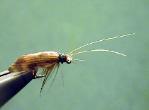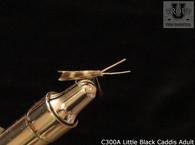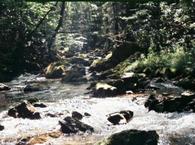
Many anglers fish the adult imitation of the caddisfly during a hatch when they first begin to see the adults around the banks of the stream. That is a mistake. Although these caddis sometimes dip down and skitter across the water after hatching, they don't really lite on the water long enough for the trout to eat them until they begin to deposit their eggs, or the males happen to fall on the water when they die. Unlike mayflies, caddisflies sometimes live a relatively long time after they hatch. They can live for a week depending on the species and weather. Just seeing caddisflies around the water doesn't mean you will be successful fishing an imitation of them.
The adult Cinnamon Caddis fly becomes important when the females are depositing their eggs. These caddisflies deposit their eggs on the surface of the water or by diving to the bottom. The method depends on the particular species. As I have previously mentioned, there are six different species of Cinnamon Caddisflies that exist in the Smokies. By the way, those species that dive to deposit their eggs on objects on the bottom do return to the surface and float for a few seconds.
As I previously have written, the egg laying activity can occur at the same time they are emerging. If this is taking place, although using the dry fly adult imitation of the caddisfly will probably provide more fun and excitement, butyou will catch more trout using the pupa imitation when they are both hatching and depositing their eggs. The egg laying activity usually starts near the end of the emergence and last for an hour or two. The overlap time is usually very short and often they don't overlap at all.
On overcast or rainy days, egg laying can start much earlier in the day. On bright clear days, it usually doesn't start until after the sun has set. It also depends on the time of year. The later in the year and the warmer the weather is, the later in the day they deposit their eggs.
Even in the low light, you should be able to see the caddisflies dipping to the water when they are depositing their eggs. Of course, that's the area where you want to place your fly. You can try to imitate the skittering manner in which the caddis flutter around on the surface but we find it best just to use a dead drift. We scare more trout than we fool by adding action to the fly. The idea is to get the fly to the same areas they are laying eggs without spooking the trout feeding on them





